
The students of the Ray Bolger Musical Theater Program show off their triple-threat talents in the UCLA Department Of Theater’s gorgeously sung-and-danced revival of Richard Rodgers and Oscar Hammerstein II’s Carousel.
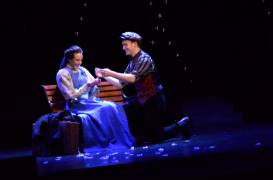 The love story of a woman who marries “below her class” and a husband who, when confronted with his own inadequacies, lashes out in the only way he knows (with a slap), Carousel has been an audience favorite since its 1945 Broadway debut.
The love story of a woman who marries “below her class” and a husband who, when confronted with his own inadequacies, lashes out in the only way he knows (with a slap), Carousel has been an audience favorite since its 1945 Broadway debut.
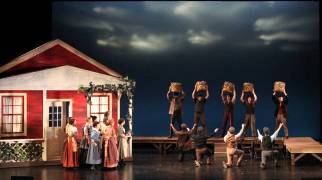 Based on Hungarian playwright Ferenc Molnár’s 1909 play Liliom, the follow-up to Rodgers & Hammerstein’s Oklahoma! transports us to a seaside Maine town circa 1873, where young girls toil daily in the local mill before escaping each night to stand in line for their turn on the town’s merry-go-round, if only to be near the carousel’s handsome, sexy barker Billy Bigelow (Michael Deni).
Based on Hungarian playwright Ferenc Molnár’s 1909 play Liliom, the follow-up to Rodgers & Hammerstein’s Oklahoma! transports us to a seaside Maine town circa 1873, where young girls toil daily in the local mill before escaping each night to stand in line for their turn on the town’s merry-go-round, if only to be near the carousel’s handsome, sexy barker Billy Bigelow (Michael Deni).
Though there’s hardly a girl in town not smitten with Billy, it’s clear from the start that the carousel barker only has eyes for the beautiful Julie Jordan (Catriona Fray) and she for him, so much so that within hours of their first conversation, the couple will have both fallen in love and lost their jobs as a consequence.
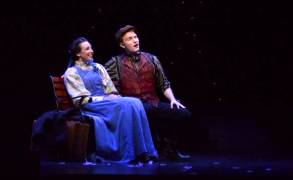 It doesn’t take long for the young lovers to marry, though what follows is hardly sunshine, lollipops, and rainbows.
It doesn’t take long for the young lovers to marry, though what follows is hardly sunshine, lollipops, and rainbows.
Two months later Billy is not only still jobless, he has hit Julie, only once so far, but that’s enough for the newlywed’s friends to advise her to cut her losses and get out of an abusive marriage, something she steadfastly refuses to do.
When Billy learns that Julie is pregnant, he makes a decision that will alter their lives forever.
 Carousel broke ground back in the mid-‘40s by daring to open, not with an overture but with an extended eight-minute “Prologue” during which the orchestral “Carousel Waltz” underscores a dialog-free introduction to the musical’s main characters, assorted townspeople, and a stageful of magicians, acrobats, and colorful carnies, a sequence that director Jeremy Mann and choreographer Christine Kellogg bring to spectacularly inventive life.
Carousel broke ground back in the mid-‘40s by daring to open, not with an overture but with an extended eight-minute “Prologue” during which the orchestral “Carousel Waltz” underscores a dialog-free introduction to the musical’s main characters, assorted townspeople, and a stageful of magicians, acrobats, and colorful carnies, a sequence that director Jeremy Mann and choreographer Christine Kellogg bring to spectacularly inventive life.
Equally revolutionary is the extended music-and-dialog sequence of Act One’s famous “bench scene” and the seven extraordinary minutes of Billy’s thematically and musically complex “Soliloquy.”
Then there’s the justly famed Act Two “Ballet,” Carousel’s follow-up to Oklahoma!’s dream ballet, in which we see through the medium of dance what it feels like to be the teenage child of a father with the reputation of being a bum … and worse.
Romantic leads Deni and Fray display terrific stage presence as Billy and Julie, and each sings to perfection, Fray showing off a glorious soprano in “What’s The Use Of Wond’rin” and Deni earning justified cheers for Billy’s “Soliloquy.”
Emily Zetterberg is a delight as Julie’s best friend Carrie Pipperidge, engaged to fisherman Enoch Snow (Nick McKenna, in the production’s most memorably scene-stealing turn) but attracted to the villainous Jigger Craigin, played here as a nigh on irresistible Brooklyn-bred bad boy by the ever so charismatic Jake Levy.
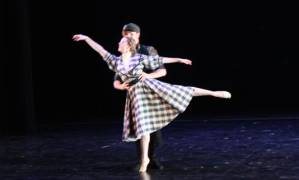 Equity Guest Artist Linda Kerns gives Cousin Nettie both warmth and gravitas, and sings “You’ll Never Walk Alone” to moving effect; Erin Dubreuil dances exquisitely as Louise; and featured turns are pleasingly rendered by Robert C. Arriaga (David Bascombe), Kyle Compton (First Heavenly Friend), Maggie Darago (Mrs. Mullin), Molly Grant (Starkeeper, Doctor Seldon), and Spencer Martin (Enoch Snow, Jr.).
Equity Guest Artist Linda Kerns gives Cousin Nettie both warmth and gravitas, and sings “You’ll Never Walk Alone” to moving effect; Erin Dubreuil dances exquisitely as Louise; and featured turns are pleasingly rendered by Robert C. Arriaga (David Bascombe), Kyle Compton (First Heavenly Friend), Maggie Darago (Mrs. Mullin), Molly Grant (Starkeeper, Doctor Seldon), and Spencer Martin (Enoch Snow, Jr.).
Reviewer’s sidebar: Only a few cast members adopt the New England accent befitting Hammerstein’s colloquial dialog, and those who don’t would benefit from some Maine in their vowels.
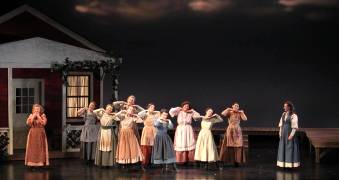 As for the production’s gifted ensemble of triple-threats, Kelly Baker, Gillian Bozajian, Calvin Brady, Compton, Flynn Hayward, Grant Hodges, Miki Holmes, Elan Kramer, Alex Levy, Olivia London, Aaron Newman, Demitra Pace, Laura Richardson, Max Risch, and Anthony Sorrells show off vocal/dance chops in “June Is Bustin’ Out All Over” and the Act Two “Ballet,” featuring Kellogg’s athletic/graceful Agnes de Mille-inspired choreography.
As for the production’s gifted ensemble of triple-threats, Kelly Baker, Gillian Bozajian, Calvin Brady, Compton, Flynn Hayward, Grant Hodges, Miki Holmes, Elan Kramer, Alex Levy, Olivia London, Aaron Newman, Demitra Pace, Laura Richardson, Max Risch, and Anthony Sorrells show off vocal/dance chops in “June Is Bustin’ Out All Over” and the Act Two “Ballet,” featuring Kellogg’s athletic/graceful Agnes de Mille-inspired choreography.
Musical director Dan Belzer shares credit for the cast’s outstanding vocals, choral numbers sweetened by pit singers Nicole Athill, Rebecca Birstock, Nettie understudy Alana DeBlase, Rodd Farhadi, Kyle Frattini, Ty Koeller, Brandon Root, and Ali Whitney, as well as for conducting a topnotch thirteen-piece pit orchestra (Richard Adkins, LaVette Allen, Brian Boyce, Rachel Coosala, Ian Dahlberg, Cheryl Lopez, Phil Moore, Emma Rostykus, Lori Stuntz, Jeff Takiguchi, Chris Wilson, and Mandy Wirt).
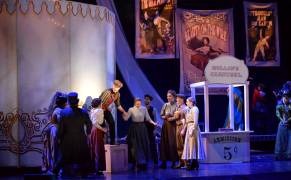 The entire production is given a thoroughly professional look on the Broadway-scale Freud Playhouse stage by a crackerjack team of designers. Ji Young Lee’s often minimalist scenic design is striking indeed as is Ginevra Lombardo’s lighting design. Jennifer Davis scores with one muted-tone period costume after another. Jonathan Burke’s sound design is his accustomed pitch-perfect mix of vocals and instrumentals. Ed Monaghan’s fight choreography earns top marks as well.
The entire production is given a thoroughly professional look on the Broadway-scale Freud Playhouse stage by a crackerjack team of designers. Ji Young Lee’s often minimalist scenic design is striking indeed as is Ginevra Lombardo’s lighting design. Jennifer Davis scores with one muted-tone period costume after another. Jonathan Burke’s sound design is his accustomed pitch-perfect mix of vocals and instrumentals. Ed Monaghan’s fight choreography earns top marks as well.
Rowan Smith is stage manager. Charles Platt is dramaturg.
Every musical theater lover has his or her favorite Rodgers & Hammerstein classic and mine is Carousel. The tears that this UCLA Department Of Theater big-stage revival brought to my eyes are proof positive that it has lost none of its power to thrill, delight, entertain, and move in equal measure.
Freud Playhouse, UCLA.
www.tft.ucla.edu
–Steven Stanley
May 7, 2016
Tags: Los Angeles Theater Review, Rodgers & Hammerstein, UCLA



 Since 2007, Steven Stanley's StageSceneLA.com has spotlighted the best in Southern California theater via reviews, interviews, and its annual StageSceneLA Scenies.
Since 2007, Steven Stanley's StageSceneLA.com has spotlighted the best in Southern California theater via reviews, interviews, and its annual StageSceneLA Scenies.







 COPYRIGHT 2025 STEVEN STANLEY :: DESIGN BY
COPYRIGHT 2025 STEVEN STANLEY :: DESIGN BY